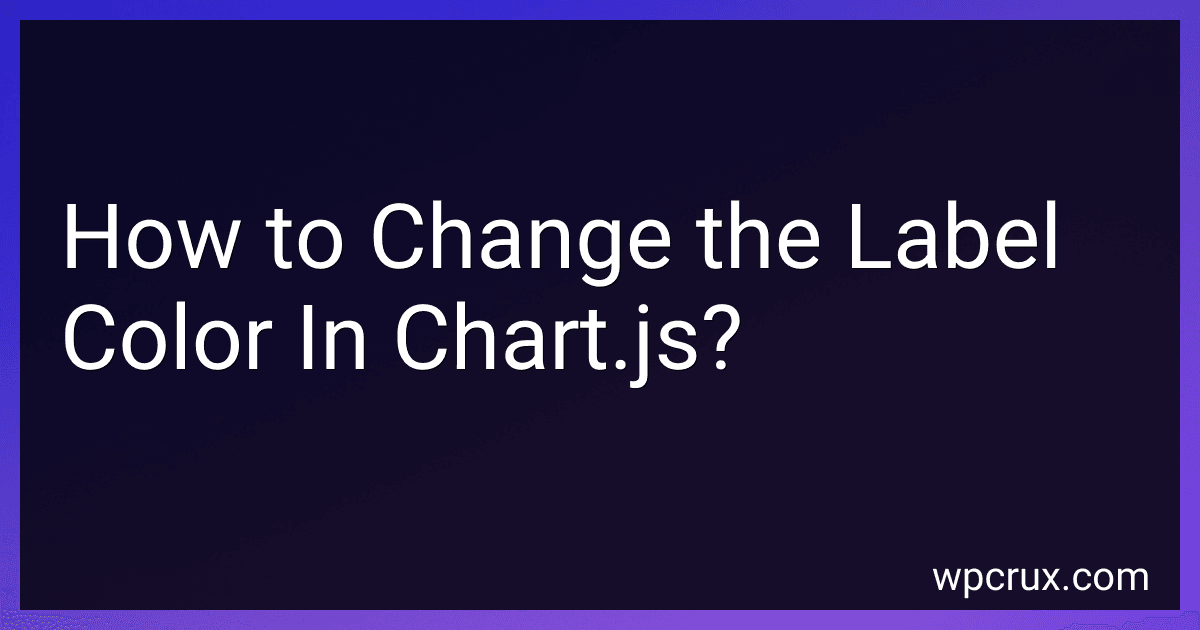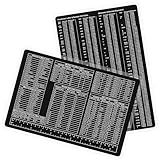Best Chart.js Customization Tools to Buy in October 2025
To change the label color in Chart.js, you can use the fontColor property within the options object. The label color can be set to any valid CSS color value.
Here's an example of how you can change the label color in Chart.js:
var ctx = document.getElementById('myChart').getContext('2d'); var myChart = new Chart(ctx, { type: 'bar', data: { labels: ['Red', 'Blue', 'Yellow', 'Green', 'Purple', 'Orange'], datasets: [{ label: 'Sample Dataset', data: [12, 19, 3, 5, 2, 3], backgroundColor: ['red', 'blue', 'yellow', 'green', 'purple', 'orange'] }] }, options: { scales: { y: { beginAtZero: true } }, plugins: { legend: { labels: { fontColor: 'black' // Set label color here } } } } });
In this example, the fontColor property is set to 'black' within the plugins object under the legend property. You can replace 'black' with any valid CSS color value to customize the label color to your preference.
How to change the label color based on user interaction in chart.js?
To change the label color based on user interaction in Chart.js, you can use the following steps:
- Create a Chart.js chart with the desired labels and customize it to your needs.
- Add an event listener for user interaction, such as 'click' or 'hover'.
- Inside the event listener, get the label or data point that the user interacted with.
- Update the color of the label or data point to the desired color using the backgroundColor property of the dataset or label object.
- Finally, update the chart by calling the update() method on the chart instance.
Here's an example code snippet to change the label color on user click:
var chart = new Chart(ctx, { type: 'bar', data: { labels: ['Label 1', 'Label 2', 'Label 3'], datasets: [{ label: 'Data', data: [10, 20, 30], backgroundColor: ['red', 'blue', 'green'] // Initial label colors }] }, options: { onClick: function(e, elements) { if (elements.length > 0) { var label = elements[0]._model.label; var datasetIndex = elements[0]._datasetIndex; var dataset = this.data.datasets[datasetIndex];
// Update the color of the label or data point
dataset.backgroundColor\[dataset.data.indexOf(label)\] = 'yellow';
// Or, if you want to update all labels:
// dataset.backgroundColor = \['yellow', 'yellow', 'yellow'\];
// Update the chart
this.update();
}
}
}
});
In this example, when the user clicks on a bar in the chart, the color of the label associated with that bar will change to yellow. You can modify the logic inside the event listener according to your specific requirements.
Note: The example provided assumes you have already created a ctx variable referencing a valid canvas element. Make sure to adjust the code accordingly for your use case.
How can I make label colors consistent across different chart types?
To make label colors consistent across different chart types, you can follow these steps:
- Define a color palette: Start by selecting a color palette that you plan to use consistently across your charts. This could include a set of colors that complement each other or align with your brand guidelines.
- Assign labels to colors: Assign specific colors from your color palette to the labels you want to represent in your charts. For example, if you have three labels (A, B, C), you might assign blue, green, and orange colors respectively.
- Use consistent labeling in all charts: Make sure to use the same label colors consistently across all your chart types. This will create visual continuity and make it easier for viewers to interpret the information.
- Set color options in charting software: If you are using charting software, explore its options for customizing label colors. Look for settings that allow you to specifically choose or define the colors you want to use.
- Adjust color schemes based on chart type: Some chart types may have unique requirements for labeling color schemes. For example, in a pie chart, you might need to use a color gradient or shading to differentiate between slices. Consider adapting your color choices to suit the specific requirements of each chart type while still maintaining consistency across all your charts.
- Opt for accessibility: Ensure your label colors are accessible to all users, including those with color vision deficiencies. Avoid using color combinations that might be difficult to distinguish for individuals with specific color vision impairments. Websites like Color Safe (colorsafe.co) can help you check the color contrast ratio and make sure your labels are easily readable.
By following these steps, you can ensure that label colors remain consistent and cohesive throughout different chart types, helping viewers understand and interpret the visual data more effectively.
What is the relationship between label colors and chart.js datasets?
In Chart.js, label colors are the colors assigned to corresponding datasets in a chart.
When creating a chart in Chart.js, you can define multiple datasets, each representing a different set of data. Each dataset can have its own label that describes the data it represents, and you can assign a specific color to each dataset's label.
The labels and colors are then used to visually differentiate between different datasets when rendering the chart. The labels are typically displayed in a chart's legend, and the colors are used in the chart's data representation, such as bars, lines, or pie slices.
By assigning unique colors to each dataset's label, Chart.js allows users to easily recognize and identify different datasets in a chart, aiding in data comprehension and analysis.
How to change the font size of labels in chart.js?
To change the font size of labels in Chart.js, you need to modify the options of the specific chart. You can achieve this by setting the fontSize property under the ticks object for the x-axis and y-axis.
Here is an example:
var chart = new Chart(ctx, { type: 'bar', data: { labels: ['Label 1', 'Label 2', 'Label 3'], datasets: [{ label: 'Dataset', data: [10, 20, 30], backgroundColor: ['red', 'blue', 'green'] }] }, options: { scales: { x: { ticks: { fontSize: 16 // set x-axis label font size } }, y: { ticks: { fontSize: 16 // set y-axis label font size } } } } });
In the above example, the fontSize property is set to 16 for both the x-axis and y-axis labels. You can adjust the font size according to your requirements.
What is the purpose of label colors in chart.js legends?
The purpose of label colors in chart.js legends is to visually associate the color of a label with the corresponding data in the chart. This helps make it easier for users to identify and understand which color represents which dataset or category in the chart. By providing a color-coded legend, chart.js enables users to interpret the chart more effectively and quickly, aiding in data comprehension and analysis.
How to set a transparent background color for labels in chart.js?
To set a transparent background color for labels in Chart.js, you can use the rgba() function to specify the desired color with an alpha value of 0.
Here is an example code snippet to achieve this:
var data = { labels: ["Label 1", "Label 2", "Label 3"], datasets: [{ data: [10, 20, 30], backgroundColor: [ 'rgba(0, 0, 0, 0)', // Transparent background color for Label 1 'rgba(0, 0, 0, 0)', // Transparent background color for Label 2 'rgba(0, 0, 0, 0)' // Transparent background color for Label 3 ], // ... }] };
var options = { // ... };
var myChart = new Chart(document.getElementById("myChart"), { type: 'bar', data: data, options: options });
In this example, the backgroundColor property of the dataset is set to an array of rgba values with an alpha value of 0. This will result in transparent background colors for the corresponding labels.
Remember to replace "myChart" with the actual ID of your chart canvas element.



